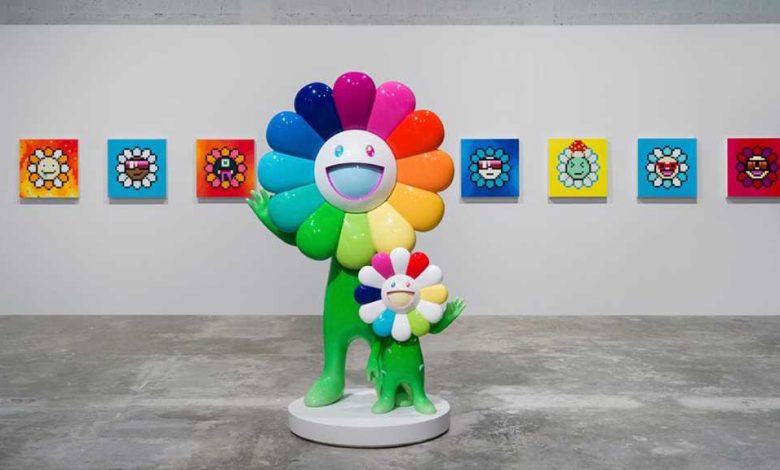
Takashi Murakami’s flower motif has blossomed into a global symbol, captivating art enthusiasts and pop culture aficionados alike. Yet, this cheerful symbol has evolved over the years, reflecting the artist’s own journey and his commentary on society.
The Seed is Planted: Nihonga Inspiration
Murakami’s artistic roots lie in Nihonga, traditional Japanese painting. He initially struggled to replicate the delicate flowers of this style, leading to the birth of his signature smiling flower in 1995. This early flower, with its wide grin and flat, cartoonish aesthetic, was a deliberate departure from the meticulous realism of Nihonga.
The Budding Superflat Movement
Murakami’s flowers quickly became emblematic of the Superflat movement he founded. This movement challenged the boundaries between “high” and “low” art, embracing the aesthetics of anime, manga, and consumer culture. The flowers, with their bright colors and cheerful demeanor, embodied this spirit, offering a critique of consumerism and mass production while simultaneously participating in it.
Growth and Diversification: The 2000s
The 2000s saw an explosion of Murakami’s flower motif. It sprouted in various forms, from large-scale sculptures and paintings to prints, clothing, and even collaborations with luxury brands like Louis Vuitton. This diversification cemented the flower’s place in popular culture, making it a ubiquitous symbol of contemporary art.
Mutations and New Meanings: Darker Undertones
As Murakami’s career progressed, so did the flower’s meaning. While it retained its cheerful facade, darker undertones emerged. The flower’s repetitive nature and mass production hinted at the dangers of conformity and the emptiness of consumer culture. Some interpretations even linked the flower to the trauma of the atomic bombings in Japan, with its bright colors masking a sense of underlying dread.
The Flower in Full Bloom: A Symbol of Resilience
Despite these darker interpretations, Murakami’s flower has also come to symbolize resilience and optimism. Its enduring popularity is a testament to its ability to adapt and resonate with diverse audiences. In a world facing numerous challenges, the flower’s unwavering smile offers a glimmer of hope and a reminder of the beauty that can emerge from adversity.
The Flower’s Legacy: Beyond Takashi Murakami
Murakami’s flower has transcended its creator, becoming a cultural phenomenon in its own right. It has inspired countless artists and designers, appearing in everything from street art to fashion runways. The flower’s legacy is a testament to Murakami’s ability to bridge the gap between high art and popular culture, creating a symbol that is both accessible and thought-provoking.
The Future of the Flower: Endless Possibilities
As Murakami continues to evolve as an artist, so too will his flower. It will undoubtedly continue to sprout in new and unexpected ways, reflecting the changing landscape of contemporary art and society. Whether it takes on new meanings or retains its familiar charm, one thing is certain: Murakami’s flower will continue to captivate and inspire for generations to come.
The evolution of Takashi Murakami’s flower motif is a fascinating journey that mirrors the artist’s own growth and his commentary on society. It is a symbol that has captured the imagination of the world, offering a unique blend of cheerfulness, critique, and resilience. As we look to the future, we can only anticipate with excitement what new forms this iconic flower will take. For those interested in a deeper analysis, explore Thinkdifferentnetwork review on smiling rainbow flower to see how this motif continues to evolve and inspire.

